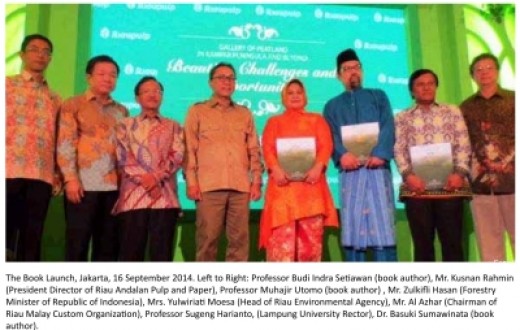Kampar Peninsula is one of the peat swamp forest ecosystems remaining on Sumatera Island, Indonesia. This area of peat swamp forest is part of the natural resources that have important functions in the conservation of water resources, flood absorbers, seawater intrusion prevention and climate control through its ability to absorb and store carbon. The peatland forest ecosystem’s sustainability is a unity that is determined by the condition of the water system and it is controlled by a dome in the middle.

In ecology, the forest ecosystem in the Kampar Peninsula is one of the key areas for biodiversity in Sumatera. This has resulted in the ecosystem being one of the focuses on stopping today’s biodiversity decline due to continuous deforestation in Sumatera. In general, land use change that has predominantly occurred in the tropics and agricultural activities globally accounts for about one-third of the total global Green House Gases (GHG) emission. In Indonesia, land and forest-use change contributes 53% of the total CO2 emission. In fact, 47% of the national CO2 emissions are generated from peatland ecosystems. The CO2 emission from peatlands is mainly caused by fires, peat decomposition and biomass removals. As these emissions are considered a serious global warming threat, Indonesia has made a non-binding commitment to reduce its GHG emissions by 26-41% by the year 2020. One of the policy options to reduce GHG emission is by enhancing peatland management practices.
In responding to the issue of CO2 emission from peatlands and to implement sustainable industrial plantation forest management, PT. Riau Andalan Pulp and Paper has improved and executed so called eco-hydro technology at Meranti Estate, Kampar Peninsula, Riau Province, Sumatera Island, Indonesia. The Ministry of Forestry Republic of Indonesia has appointed a Measurement, Reporting and Verification (MRV) team in 2010. The MRV team is in charge of carrying out the measurement, reporting and verification (MRV) of eco-hydro management implemented by RAPP in peatland in Kampar Peninsula, Riau Province.
During the MRV activities, beauties, challenges and opportunities of peatland in Kampar Peninsula and beyond were captured by Professor Muhajir Utomo and Dr. Basuki Sumawinata. The book authors are Professor Muhajir Utomo, Dr. Basuki Sumawinata and Professor Budi Indra Setiawan; members of the MRV team. This photo book describes the natural richness of Indonesia, in particular location in Kampar Peninsula as peat swamp forest area which is located in Riau Province.

Industrial plantation forest (HTI) development in Kampar Ring must implement landscape approach given the Kampar Ring is one entity of ecosystem and water management in Kampar Peninsula in the provincial and district scales in the preparation to participate in efforts to mitigate climate change. This approach is done to ensure that up to how much influence the evelopment of industrial plantation forest in Kampar Ring with water management “eco-hydro” implemented by industrial plantation forest of RAPP to the water system in Kampar Peninsula as well as the connectivity of high conservation value forest functioned as endemic wildlife corridor to the broader habitat.
The book was launched by Forestry Minister of Republic of Indonesia. The authors hope that this photo book can enhance the knowledge base and enrich the wealth of Indonesia’s forest visualization as well as the community social economy living in the forest and surrounding forest in Indonesia. They also hope to expose challenges ahead that must be faced by all of us.
